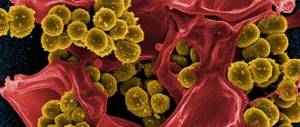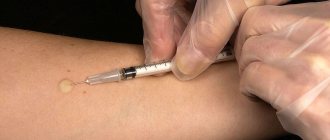General information
The causative agent of the infection is DNA viruses from the Adenoviridae family. Scientists have been able to identify about 100 serological variants of this virus, but only 40 of them cause disease in humans. Some of the virus varieties prefer to multiply in the upper respiratory tract, while others have a tropism for lymphoid tissue. 5 out of 40 serotypes cause outbreaks of infection in communities.
The disease is transmitted exclusively from person to person by airborne droplets or fecal-oral route. Viruses are very stable in the external environment and persist indoors for up to 14 days. They die under the influence of ultraviolet rays, which is used to disinfect premises and prevent the spread of the virus.
The source of infection can be a sick person or a carrier of the virus. Until the 25th day from the onset of the disease, a person is considered infectious. The infectious agent is excreted in feces for 1.5 months after recovery.
Human susceptibility to the virus is very high. Most often, the disease is recorded in the cold season. Mostly children from 6 months to 3 years are affected. The disease almost never occurs in babies in the first months of life. Quite often there are outbreaks of infection in newly formed teams. After recovery, stable type-specific immunity is formed (immunity to a specific type of virus).
Adenoviral infection in children - how it is transmitted, symptoms, treatment
Adenoviral infection in children at the household level is more often called ARVI. As a rule, parents do not bother themselves much with identifying the virus that caused the disease. The main thing is that the child is sick.
Experience with infectious diseases suggests that adenovirus can infect even if someone’s child has already been ill. Within 25 days after illness, adenovirus can infect a healthy child upon contact with a carrier.
The situation is typical for kindergartens and schools. It is almost impossible to protect children from communication in these groups. This is why wave-like infection occurs within a couple of weeks from the start.
Features of adenovirus infection in children
Adenovirus infection in children is much more common than in adult patients. Also, in children and adolescents, the infection occurs with a more vivid clinical picture.
Symptoms of the infectious process may include:
- lymphoid structures,
- respiratory tract,
- ocular conjunctiva,
- mucous and lymphatic structures of the intestine.
For reference. In addition to specific symptoms, the disease is accompanied by the appearance of intoxication and febrile symptoms, as well as catarrhal manifestations with pronounced exudative components (productive wet cough, discharge of mucus from the nasal passages).
Up to six months, immunity is supported through breastfeeding. With mother's milk, the baby receives a full set of antibodies. In this regard, passive immunity does not provide opportunities for a serious viral attack.
Having stable immunity in the event of illness reduces symptoms and consequences.
However, over time, the body's protective properties decrease. In the period from 6 months to a year, the risks of an infectious disease gradually increase.
Attention. After one year of age, the risks of adding a bacterial component increase, which will intensify the course of the disease in case of infection. The consequences of the disease also become more complex.
The causative agents of the disease are distinguished by high rates of resistance in the OS (environment). Pathogens tolerate freezing well. When released into water (at temperatures up to four degrees), the pathogen can remain viable for two years.
Attention. On household items and clothing, adenoviruses can remain active for from ten to forty-five days.
Also, the causative agent of the infectious process is not destroyed when treated with ethers and lipid solvents.
When exposed to ultraviolet radiation, treated with chlorine-containing disinfectants. means or at temperatures above fifty-six degrees, the virus is inactivated within half an hour.
How is adenovirus infection transmitted in children?
The source of the causative agent of adenoviral infection (AI) is a patient with an active form of pathology or a healthy virus carrier. At the same time, healthy carriers of viruses play a critical role in the development of outbreaks of adenovirus infection in children and adults.
A patient without symptoms of the disease continues to actively release viruses into the OS, contributing to the infection of others.
Attention. Virus shedding can be observed up to forty to fifty days after infection.
The causative agent of adenoviral infection can be released into the OS with mucus and feces. In the first days of the disease, viruses are most actively released with mucus particles (coughing, sneezing, etc.). In the later stages of the disease, as well as in intestinal forms of the disease, viruses are actively excreted in the feces.
The most common mechanisms of infection transmission are:
- fecal-oral;
- contact and household;
- food.
Also, in rare cases, intrauterine infection of the fetus is observed.
The natural level of susceptibility to the pathogen in children is high. In adults, the disease is registered less frequently and often occurs in mild forms (due to the formation of species-specific immune reactions).
For reference. Outbreaks of adenovirus infection in children are most often recorded in the cold season. The exception is outbreaks of pharyngoconjunctival fever and epidemic keratoconjunctivitis, often recorded in the summer.
The form of the disease depends on the serotype of adenovirus that has entered the body.
Why coronavirus is dangerous, treatment and prevention
The incubation period can range from a day to several weeks.
Pathogenesis of adenovirus infection in children
After the virus enters the body, the process of its active reproduction in the affected cells begins. After this, it penetrates the blood, triggering a wave of viremia.
Clinically, this process can be manifested by the development of such specific symptoms of adenoviral infection in children as:
- pharyngoconjunctival fever;
- catarrh of the respiratory tract (in mild forms of the disease, the upper respiratory tract is affected, and in moderate and severe infections, adenoviral bronchitis and pneumonia can develop);
- keratoconjunctivitis;
- diarrheal symptoms;
- damage to lymphoid structures;
- widespread exanthema (rash due to adenoviral infection in children is much more common than in adults).
Adenoviral infection in children - symptoms
Attention. The infectious process caused by adenoviruses always begins acutely. The first manifestation of adenovirus infection in children is intoxication symptoms.
Intoxication manifestations can vary from moderate to severe. Patients are concerned about the appearance of headaches, severe weakness, lethargy, muscle and joint pain. Nausea and vomiting are also common.
Appetite is reduced. Young children may experience moodiness and tearfulness.
The temperature during adenovirus infection in children rises from the first days of the disease. The maximum severity of fever is usually observed in the first two to three days of illness.
However, elevated temperature in children can last from five to ten days.
The most specific tetrad of symptoms for adenovirus infection in children is the presence of:
- acute rhinitis;
- acute pharyngitis;
- acute inflammation of the conjunctiva of the eyes (conjunctivitis);
- severe febrile symptoms.
For reference. Diarrheal symptoms are common in young children.
A typical manifestation of adenoviral infection is also catarrhal inflammation of the respiratory tract. Exudative components predominate in the inflammatory process, so patients experience:
- copious discharge of non-viscous and non-purulent mucus from the nasal passages;
- productive, wet coughs.
Young children often cannot blow their nose or cough normally, so they experience copious amounts of mucus running down the back of the throat. It is due to the constant flow of mucus that children vomit more often.
Against the background of constant ingestion of mucus containing viruses, children are also more likely than adults to experience damage to the lymphoid structures of the intestine (mesadenitis).
Adenoviral pharyngitis is manifested by sore throat (increased when swallowing), an increase in the size of the tonsils (thin filmy deposits may be noted), granularity and hyperemia of the posterior wall of the pharynx.
For reference. Young children also often experience severe symptoms of adenoiditis (nasal voice, night snoring, severe nasal congestion, mucus running down the back of the throat, etc.).
On the second to fourth days of the disease, children often experience the development of adenoviral bronchitis or pneumonia.
Damage to lymphoid structures is accompanied by an increase in the submandibular, cervical, occipital, etc. lymph nodes
Lymph nodes are dense, moderately painful on palpation, not fused and mobile. The skin over the inflamed lymph nodes is not changed.
Suppuration of the lymph nodes is uncharacteristic. The suppurative process can develop only with the addition of a secondary bacterial component.
In this case, the appearance of sharp pain in the lymph node, hyperemia of the skin over it, softening in the center of the lymph node and a symptom of fluctuation are noted.
Stenosing laryngotracheitis
For reference. Also, a common symptom of adenovirus infection in young children is acute stenosing laryngotracheitis. Obstructive symptoms may persist for up to three weeks.
The manifestation of signs of stenosing laryngotracheitis is an indication for mandatory emergency hospitalization in a hospital.
The development of stenosing laryngotracheitis is accompanied by the appearance of:
- hoarseness of voice;
- rough barking cough;
- noisy breathing;
- severe anxiety or lethargy of the patient;
- mixed shortness of breath;
- pallor of the face and cyanosis of the nasolabial triangle;
- retraction of intercostal spaces;
- retraction of the supraclavicular and/or subclavian fossa.
Coronavirus news from Italy
Eye damage due to AI
Symptoms of inflammation of the ocular conjunctiva develop within a few days from the onset of the infectious process. Patients are concerned about pain in the eyes, increased sensitivity of the eyes to light, dry mucous membranes, a burning sensation and sand in the eyes.
There may also be discharge of mucous discharge and increased lacrimation.
The appearance of the patient is also characteristic: swollen face, swollen and hyperemic eyelids, narrowing of the palpebral fissures, gluing of eyelashes.
The mucous membrane of the eye is swollen, multiple hemorrhages are noted in the conjunctiva.
By the second or third day of the disease, the development of granularity of the conjunctiva due to inflammatory hypertrophy of the follicles is noted.
In membranous forms of conjunctivitis, thin whitish films appear. Rejection of the films occurs independently and does not lead to the appearance of ulcerative defects of the mucous membranes.
With the addition of keratoconjunctivitis, the appearance of foci of opacification on the cornea and subepithelial infiltrates is noted.
For reference. The course of keratoconjunctivitis is benign and is not accompanied by corneal ulceration and loss of vision. The decrease in visual acuity is temporary. Vision recovery occurs within several months after the infection.
With the development of adenoviral mesadenitis in children, damage to the lymphoid structures of the small intestine is observed (acute inflammatory processes in the mesenteric lymph nodes).
The clinical picture of adenoviral mesadenitis resembles that of an acute abdomen, so a differential is performed. diagnosis of acute appendicitis.
With the development of acute adenoviral mesadenitis, patients are bothered by abdominal pain, feverish and intoxication symptoms, nausea and vomiting, increased heart rate, the appearance of shortness of breath, headaches, etc.
Attention. Pain with adenoviral mesadenitis is usually localized near the navel. Less often in the lower abdomen (usually on the right).
There is no bloating, and the stomach also actively participates in the act of breathing.
When palpating the abdomen, the pain intensifies.
When carrying out differential diagnosis with appendicitis, the following testifies in favor of acute adenoviral mesadenitis:
- acute onset of the disease;
- the presence of symptoms of adenovirus infection (conjunctivitis, febrile and intoxication symptoms, symptoms of pharyngitis, lymphadenopathy);
- the presence of persistent febrile symptoms;
- the appearance of a high level of leukocytes in a blood test (in the absence of signs of peritonitis);
- earlier appearance of intoxication symptoms;
- absence of signs of appendicitis on ultrasound and detection of enlarged mesenteric lymph nodes.
Hepatosplenomegaly is also often detected.
If necessary, laparoscopic diagnosis is performed to confirm the diagnosis.
Adenoviral pneumonia
In most cases, pneumonia in AI occurs as bronchopneumonia (bronchial pneumonia).
The main manifestations of adenoviral pneumonia are:
- febrile and intoxication symptoms;
- dry and then wet productive cough;
- the appearance of a boxed sound during percussion;
- varying degrees of wheezing in the lungs during auscultation;
- X-ray changes specific to pneumonia;
- shortness of breath symptoms;
- increased fatigue;
- chest pain (often worse after coughing);
- Tachycardia and muffled heart sounds may occur.
For reference. Also, in addition to the classic picture of pneumonia, symptoms characteristic of AI are noted: conjunctivitis, enlarged and painful lymph nodes, symptoms of pharyngitis and rhinitis.
The diagnosis is made based on clinical symptoms and epidemiological data. A general blood test is also performed.
If necessary, to exclude the development of complications, ultrasound, ECG, chest x-ray, etc. are performed.
A consultation with an ENT doctor (sinusitis, otitis) or a surgeon (mesadenitis) may also be indicated.
To confirm the diagnosis, rapid diagnostics (ELISA, RIF), etc. can be performed.
Adenoviral infection in children - treatment
For mild cases of the disease, treatment is symptomatic. Bed rest for the period of fever and vitamin therapy are indicated. According to indications, antiviral drugs, interferons and interferon inducer drugs can be used.
If necessary, antipyretics, mucolytics, vasoconstrictor nasal drops, eye drops with interferon, etc. are used.
Attention! Antibiotics for adenoviral therapy in children are used only in complicated forms of the disease and the addition of a bacterial component.
Source: https://klinikanz.ru/adenovirusnaya-infekciya-u-detej/
Development of the disease
Infectious agents penetrate the respiratory tract and quickly spread from the nasopharynx to the trachea and bronchi. The virus begins to multiply in the cells of the mucous membranes. Inflammation develops with damage to the pharynx, larynx, conjunctiva, digestive tract and lymphoid tissue. Quite rarely, the virus penetrates the membranes of the brain, causing meningitis and meningoencephalitis.
The incubation period lasts from 3 to 7 days. At this time, the child does not show any symptoms of the disease. The course of the infection is slow and wave-like. Most children have isolated damage to the upper respiratory tract and conjunctiva. Inflammation of the digestive tract occurs mainly before the age of 2 years.
Adenovirus infection in children: symptoms, prevention and treatment methods
The cold weather sets in, and children begin to get sick much more often. Parents stubbornly call doctors, and they stubbornly diagnose ARVI.
The structure of acute respiratory viral infections (ARVI) includes many infectious agents.
Influenza is invariably considered the most terrible and unpleasant, followed by adenovirus infection in children, which can progress to almost any complications.
Adenovirus affects the upper and lower respiratory tract, contributes to the development of pharyngitis, tracheitis, bronchitis, and is often the cause of pneumonia1.
The disease affects children at any age, but is especially difficult to tolerate up to three years of age. Adenoviral infection can penetrate the body all year round, but the main increase in incidence is observed in the winter-spring period; local outbreaks begin to form everywhere, especially in closed children's groups.
What is adenovirus infection?
Having found out that adenoviral infection is a type of acute respiratory viral infection, we should consider it in more detail.
The main portal of infection is the upper respiratory tract, and less commonly the conjunctiva of the eyes. It has been noted that the virus multiplies at tremendous speed, easily penetrates the blood from the affected area and spreads further throughout the body. In addition to blood vessels, adenoviruses can use lymph nodes and lymphatic tracts as a road.
The causative agent is a virus containing a DNA molecule. The infection lingers on the mucous membranes of the respiratory system and descends below, affecting the intestines. Quite often, lymphoid tissue is infected. The conjunctiva of the eyes also suggests that adenoviruses may be the culprit2.
Prevalence and routes of infection
Most often, adenoviruses enter the body by airborne droplets, that is, in the usual way for any virus from the ARVI group. Much less often, infection occurs through contact. The child played with a sick friend's toy and then rubbed his eyes - a standard infection scenario.
In fact, the human body must protect itself from an infectious disease; immunity comes to the rescue.
But in fact, weakened by the cold season, the child’s local immunity is not able to resist the virus at the main entry gate.
General immunity, due to age, is also not sufficiently resistant to viral infection. This is where the statistics show that children get sick much more often than adults.
Adenoviruses account for about 17% of all cases of acute respiratory diseases. Considering that there are more than 100 viral pathogens, and that there are also bacterial pathogens, the figure on a general scale is impressive2.
Almost always, adenovirus infection occurs in the form of an epidemic outbreak, that is, a group of children in contact with each other is affected. The virus can spread throughout the body, diligently multiplying, within 1-3 weeks.
Symptoms of adenoviral infection in children and their frequency of manifestation
Once in the child’s body, the virus enters the stage of the incubation period, that is, maturation. For 4 to 14 days, more often 5-7 days, the child may not show any signs of the disease. The disease manifests itself acutely or increases gradually.
External symptoms that any doctor can identify include2:
- Copious mucous discharge from the nose;
- Flushing of the pharynx or redness of the mouth;
- Swelling of the tongue;
- Development of pharyngitis;
- Change in the appearance of the tonsils;
- Red eyes and conjunctivitis;
- Increasing intoxication of the body - lethargy, weakness, headache, loss of appetite and nausea;
- Diarrhea, especially in young children;
- Temperature rises to 38–38.5° C.
After many years of studying various manifestations of acute respiratory viral infections, including adenovirus infection, doctors have deduced the frequency of occurrence of certain symptoms, which may indicate a specific virus.
- The most common symptom is fever, which occurs in 96% of cases.
- In 88% of cases with adenovirus infection, pharyngitis develops, and its duration is on average 5 days.
- Cough occurs in 78% of children with adenovirus. The likelihood of a dry and wet cough is approximately the same.
- In 67% of cases, rhinitis with mucous discharge from the nose is observed.
- Enlargement of the cervical lymph nodes is observed in 60% of patients.
- When listening to the lungs, wheezing is detected in 36% of cases.
- In 28% of children, there is a slight enlargement of the tonsils.
- A third may experience complications. The inflammatory process can develop into bronchitis, laryngotracheitis and pneumonia.
- Conjunctivitis is quite rare, but a clear sign of adenovirus infection, which occurs in every fifth person.
- Intestinal disorders have been reported in 22% of children, with a clear predominance in early childhood, in newborns and up to three years of age3.
Parents should pay attention to three stages of symptoms in their child, which are listed in the memo below. After the first segment, you need to seek medical help:
- The first manifestations of adenoviral infection. The child developed a fever, stopped being active, and began complaining of headaches.
- Distribution to all respiratory organs. Coughing, wheezing, sore throat appear, shortness of breath, runny nose occurs, and the child’s voice changes.
- Further progression of the disease. The eyes turn red, and the mucous membrane becomes inflamed (conjunctivitis), and gastrointestinal problems, diarrhea and vomiting may begin.
The following forms are distinguished according to severity:
- A mild form of the disease involves mild symptoms and a slight increase in temperature. In most cases, the disease subsides within a week.
- The moderate-severe form is characterized by severe symptoms of intoxication, fever and chills. The temperature reaches 38° C or more, the disease lasts a long time and complications are possible.
- In severe cases of the disease, the child’s body is subjected to a serious test. The disease almost always leads to complications - bronchitis develops, the liver can increase in size. With this type of disease, hospital treatment will likely be required.
Diagnosis of adenoviral infection
Diagnosing adenovirus infection in most cases is not difficult. The doctor collects anamnesis, conducts an examination, identifies characteristic symptoms and makes a diagnosis based on them. This method is called clinical. It is especially accurate when the disease is widespread, in winter or spring.
In rare cases, a more accurate diagnosis of adenoviruses is required due to the similarity of symptoms to influenza or other, more rare respiratory infections. In this case, laboratory research methods are used, blood is taken for analysis4.
There is an accurate method for detecting adenovirus infection through blood testing.
As additional diagnostic measures, microscopic examinations of the contents of the nose and oropharynx can be carried out to exclude a bacterial infection.
Symptoms
There are several forms of adenovirus infection. All manifestations of the disease are characterized by a tetrad of symptoms:
- rhinitis (inflammation of the nasal mucosa);
- pharyngitis (damage to the tissues of the pharynx);
- conjunctivitis (inflammation of the mucous membrane of the eyes);
- fever.
Advice
If any of these symptoms appear, be sure to call a doctor!
Adenoviral infection similar to ARVI
This form of the disease is characterized by the following symptoms:
- increase in body temperature to 37-38.5 °C;
- severe runny nose with copious mucous discharge;
- nasal congestion on one or both sides;
- sore or mild sore throat;
- redness of the eyelids and conjunctiva;
- entrainment of regional lymph nodes.
The disease develops acutely with general weakness and drowsiness. Headaches, joint stiffness, and apathy appear. On the second day of the disease, body temperature rises and chills occur. Most children have a temperature between 37.5-38 °C.
Simultaneously with the development of fever, all signs of damage to the upper respiratory tract appear. With intact immunity, the disease rarely lasts more than 7 days. In young children, pneumonia may develop 2-3 days after the onset of the disease.
Pharyngoconjunctival fever
A typical form of adenoviral infection, accompanied by the following symptoms:
- increase in body temperature to 38-39 °C;
- severe sore throat;
- dry hacking cough;
- enlargement of the palatine and pharyngeal tonsils;
- nasal congestion;
- lacrimation;
- redness and swelling of the conjunctiva;
- enlarged cervical lymph nodes.
High body temperature persists for up to 5-10 days. A runny nose, cough, and watery eyes may last up to 14 days. Against the background of fever in young children, enlargement of the liver and spleen is possible. Typically, the tonsils are affected with the formation of a thin whitish coating on their surface.
Epidemic keratoconjunctivitis
Adenovirus infection in children can occur with severe isolated eye damage. In this case, the following symptoms appear:
- pain and burning in the eyes;
- severe lacrimation;
- corneal clouding;
- fever.
Damage to the cornea during epidemic keratoconjunctivitis can lead to a sharp decrease in vision and even complete blindness. Self-medication is unacceptable! The treatment regimen is selected by an ophthalmologist taking into account the child’s age and the severity of corneal damage.
Adenoviral pneumonia
Pneumonia develops 2-3 days from the onset of the disease. Young children, as well as people with reduced immunity, are more likely to get sick. The cause of pneumonia is the virus itself, and not a secondary bacterial infection, as in the case of other acute respiratory viral infections.
Viral pneumonia is characterized by the following symptoms:
- high body temperature;
- severe weakness;
- severe cough with a lot of sputum;
- dyspnea.
Treatment of pneumonia is carried out in a hospital under 24-hour medical supervision.
Symptoms of adenovirus infection
The clinical picture of the disease is distinguished by its diversity - the course of the disease largely depends on the severity of the disease and the individual characteristics of the patient’s body.
The incubation period is no more than a day; in rare cases, under the influence of external factors, the period can extend up to 2 weeks. Symptoms of the disease intensify as the disease progresses; the first signs of adenovirus infection include:
- temperature increase;
- the appearance of sore throat and sore throat;
- depressed state;
- nasal congestion, cough.
After 2-3 days, the maximum temperature for adenoviral infection can reach 39 degrees, approaching the critical level. The throat is inflamed and the lymph nodes are swollen. Migraine attacks, joint pain, lack of appetite and general lethargy of the body are constant companions of the disease.
The patient has no appetite, in some cases there are signs of poisoning: vomiting, loose stools, stomach pain, etc.
Complications
Adenoviral infection provokes the development of such complications:
- sinusitis (inflammation of the sinuses);
- otitis;
- angina;
- secondary bacterial pneumonia;
- meningitis;
- laryngospasm.
Atypical adenoviral pneumonia is considered as a separate form of the disease. In this case, the addition of a secondary bacterial infection cannot be ruled out. Laryngospasm and attacks of difficulty breathing occur mainly in children under 3 years of age.
Advice
To avoid complications, consult a doctor when the first signs of the disease appear.
Diagnostics
The diagnosis is made based on the typical manifestations of the disease. When an infection develops in children's groups, diagnosis can be difficult due to the blurred picture of the disease. In many children, adenoviral infection occurs under the guise of a common acute respiratory viral infection with minor damage to the mucous membrane of the eyes.
Serological methods can be used for diagnosis: RSK and ELISA. To identify the pathogen, blood or a scraping is taken from the mucous membrane of the respiratory tract. Targeted diagnostics are usually carried out in a hospital setting.
Principles of treatment
Specific antiviral therapy has not been developed. In practice, symptomatic remedies are used to alleviate the condition of a sick child.
Non-drug therapy
- Bed rest for the entire period of fever.
- Diet (full nutrition with an increase in the proportion of protein).
- Drink plenty of warm drinks (weak tea, fruit juice, jelly, compote, herbal decoctions).
- Frequent ventilation of the room.
- Using humidifiers.
- Daily wet cleaning of the room in which the sick child is located.
- Short walks after body temperature normalizes.
If all recommendations are followed, the child’s recovery is much faster, and the disease is rarely accompanied by the development of complications.
Children of the first year of life deserve special attention. During the height of the disease, no new food is introduced and the artificial mixture does not change. The child's condition should be closely monitored. You can't force feed. Formula-fed babies can be offered warm water from a bottle. Breastfeeding should be given to babies as often as possible. Antibodies contained in breast milk will help the baby cope with the virus faster and speed up recovery.
Drug therapy
Paracetamol or ibuprofen-based drugs are used as antipyretic drugs in children. Aspirin is prohibited for use in children! The dosage of the drug will depend on the child’s age and body weight.
Antipyretics are traditionally prescribed in a short course of 3 days. With adenovirus infection, fever often persists for 5 days or more. In this case, it is necessary to consult a doctor and adjust the dose of the antipyretic taking into account the duration of the disease.
Pediatricians recommend reducing body temperature above 39 °C. At lower temperatures, antipyretic drugs should not be used. In children of the first year of life and those prone to developing seizures, the temperature can be reduced from 38 °C.
Preparations based on sea water are used to treat rhinitis. These products gently cleanse the nasal mucosa, prevent the formation of crusts and prevent the virus from penetrating the lower respiratory tract. You need to rinse your nose every 2-3 hours throughout the day.
Vasoconstrictor drugs are prescribed in a short course for no more than 5 days in a row. The choice of medication will depend on the age of the child. Before using vasoconstrictors, you should rinse your nose with saline solutions.
For sore throat and sore throat, antiseptic agents in the form of sprays are prescribed. For older children, you can offer dissolving tablets. You can gargle with herbal decoctions (eucalyptus, chamomile, calendula).
Mucolytic drugs that dilute sputum are used only for damage to the lower respiratory tract. With ordinary pharyngitis (inflammation of the pharynx), their use does not make sense. Mucolytics are selected by a doctor for proven tracheitis, bronchitis or pneumonia.
Antibacterial agents are not used for adenoviral infection. Their use is justified only when a secondary bacterial infection develops. The doctor prescribes antibiotics. Independent use of such strong drugs is unacceptable.
Adenoviral infection in children: symptoms and treatment of the disease
24.11.2017
Good day, dear readers. Today we will talk about what adenovirus infection is in children and the treatment of this disease. You will learn what symptoms this disease is characterized by, for what reasons it occurs, what it can lead to and what to do to protect your baby from infection.
Classification
Based on the fact that adenoviruses can infect various organs, six types of possible diseases are distinguished.
- Pharyngoconjunctival fever. This disease usually lasts up to two weeks. Characterized by a periodic increase in temperature, which can remain at a high level for a week (as a result of an inflammatory process in the pharynx). Characterized by enlarged lymph nodes, inflammation of the mucous membranes of the eyes, tonsils, and in rare cases, the spleen and liver.
- Mesadenitis. With this type of infectious lesion, severe pain in the abdomen of a paroxysmal nature is observed, which is clinically similar to appendicitis. Also characteristic is a rise in temperature and vomiting, which does not bring relief.
- Qatar of the upper respiratory tract. Occurs most often. Hyperthermia for up to four days, while the body will experience moderate intoxication. The main manifestations of this condition include bronchitis and rhinitis. Enlarged lymph nodes are also possible.
- Tonsillopharyngitis. This form of adenoviral infection will be established when inflammatory processes in the nasopharynx predominate over other signs of the disease. Characterized by an increase in the size of the tonsils and the formation of a whitish coating on them. When a bacterial infection occurs, a sore throat develops.
- Keratoconjunctivitis. This condition is extremely rare. It is characterized by damage to the mucous membrane of the corneas, eyelids, pain in the eyes, an acute reaction to light, and clouding in the cornea.
- Diarrheal syndrome. This condition is observed in children of the first year of life with an intestinal infection. With this diagnosis, inclusions of mucus will be found in the stool, but without blood.
Pathogenesis
The causative agents of the disease are adenoviruses.
The source of infection is a sick person who is in an acute stage and intensively releases viruses into the environment, as well as carriers of viruses.
The incubation period ends when viremia occurs, that is, new viruses are released from dead precursors, enter the bloodstream and are transported to various organs.
This infection is characterized by three routes of transmission:
- airborne - characteristic of the period when an infected person secretes viruses with mucus from the nose or throat;
- fecal-oral - the virus is excreted in feces;
- water - infection occurs upon contact with water in which a sick person has been, so you can pick up pathogens by going to a swimming pool.
Symptoms
Cough and fever are among the first symptoms of adenovirus infection
Adenovirus infection in children, temperature is a constant companion of the disease. Let's look at what other main signs adenoviruses can cause in a child's body:
- headache;
- chills;
- cough;
- pain in the eyes, pain;
- dyspnea;
- copious mucus secretion;
- pharyngoconjunctival fever;
- diarrhea;
- paroxysmal abdominal pain;
- swelling of the nasolabial sinuses;
- enlarged lymph nodes;
- aching bone pain;
- conjunctivitis.
A patient whose body is infected with adenoviruses will not necessarily exhibit all of the above symptoms. Symptoms will depend on which organ received the “maximum impact.” Therefore, it is possible that in your case, only a couple of signs of the disease will be present.
In addition, it is worth considering individual cases of manifestations of adenoviral infection:
- possible damage to the upper respiratory tract up to the bronchial tree, this condition will be characterized by a dry cough of a barking nature, the presence of wheezing, cyanosis of the nasolabial triangle, hoarseness of voice;
- if the virus penetrates the mucous membrane of the eyes, then photophobia, lacrimation, hyperemia, foreign body sensation, burning, itching will be characteristic;
- a rash accompanies this infection mainly in children of the first year of life, initially covers the face, then spreads to other parts of the body;
- if the lungs are affected and pathogenic bacteria are attached, then pneumonia develops with its characteristic symptoms;
- adenoviruses can influence the simultaneous development of conjunctivitis with sore throat and their inherent symptoms.
Features in children under one year old
Infants infected with adenoviruses will experience the following symptoms:
- hyperthermia, which is accompanied by cough and nasal congestion;
- difficulty breathing, which prevents you from fully performing the act of eating;
- moodiness, anxiety;
- liquefaction of feces.
Children in the first year of life may experience severe convulsions due to fever.
Diagnostics
The doctor will suspect an adenovirus infection in your baby if:
- temperature;
- polyadenitis;
- conjunctivitis;
- fever;
- hyperplasia of pharyngeal lymphoid tissue;
- catarrh of the respiratory tract.
In order to make sure that he is right, the specialist will refer the baby to certain studies, which may include:
- immune electron microscopy;
- complement fixation test;
- linked immunosorbent assay;
- immunofluorescence reaction;
- bacteriological culture of scrapings from the mucous membrane of the eyes;
- hemagglutination inhibition reaction;
- examination of a swab from the throat or nose.
Additional tests will be necessary to exclude diseases with similar symptoms, in particular:
Possible complications
Lack of treatment can lead to complications
These include:
- angina;
- pneumonia;
- hyperplasia of intestinal lymphoid tissue;
- conjunctival hyperemia;
- immunosuppression;
- neurotoxicosis;
- pyelonephritis.
Treatment
Depending on how the disease manifests itself, the course of therapy may vary. Basically it includes standard groups of drugs.
- Antipyretics, for example Nurofen.
- Vasoconstrictor drops, for example, Vibrocil or Nazivin.
- Saline solutions for rinsing the nose, for example, Aquamaris.
- Antitussive drugs are often prescribed Ambrobene or Lazolvan.
- Immunomodulators, for example, Viferon.
- If a bacterial process has joined, then antibiotics are prescribed.
Traditional methods
Our grandmothers have long fought viruses using herbal infusions and other methods of traditional medicine. For adenovirus infection, you can also go this route. However, it is worth considering that herbs alone will not be enough for a complete cure. Therefore, it is worth using drug therapy.
The most commonly used means include:
- herbal decoctions of currants, sage, linden or chamomile;
- herbal and salt rinses are used to gargle; For this purpose, chamomile, calendula, sage, oak bark, eucalyptus, and sea salt are used;
- Warm milk with the addition of soda can be used as mucolytics;
- for washing the conjunctiva, tea leaves or chamomile decoction;
- to get rid of nasal congestion, you can rinse with sea water, and for children older than one year, drip the nose with beetroot or carrot juice, but only freshly squeezed;
- To strengthen the immune system, use cranberry juice or rosehip decoction.
Prevention
A healthy lifestyle improves a child’s immunity
To prevent your child from becoming infected with adenoviruses, you need to follow a number of rules.
- Boosting immunity. For this purpose, special attention should be paid to hardening procedures, vitamin therapy, and physical activity.
- Timely isolation of a healthy baby from an infected one.
- During the epidemic outbreak season, take immunomodulators.
- If there is contact with a presumably infected child, immediately take antiviral drugs.
- Regular ventilation, humidification of the room, maintaining optimal humidity and temperature.
Now you know what adenovirus infection is in children and the symptoms of this condition. Remember to follow preventative measures. Do not forget about the need to promptly contact a specialist at the slightest suspicion of changes in the baby’s well-being. Health to you and your children!
Source: https://zdorovyemalisha.ru/zdorovye/adenovirusnaya-infektsiya-u-detej.html












